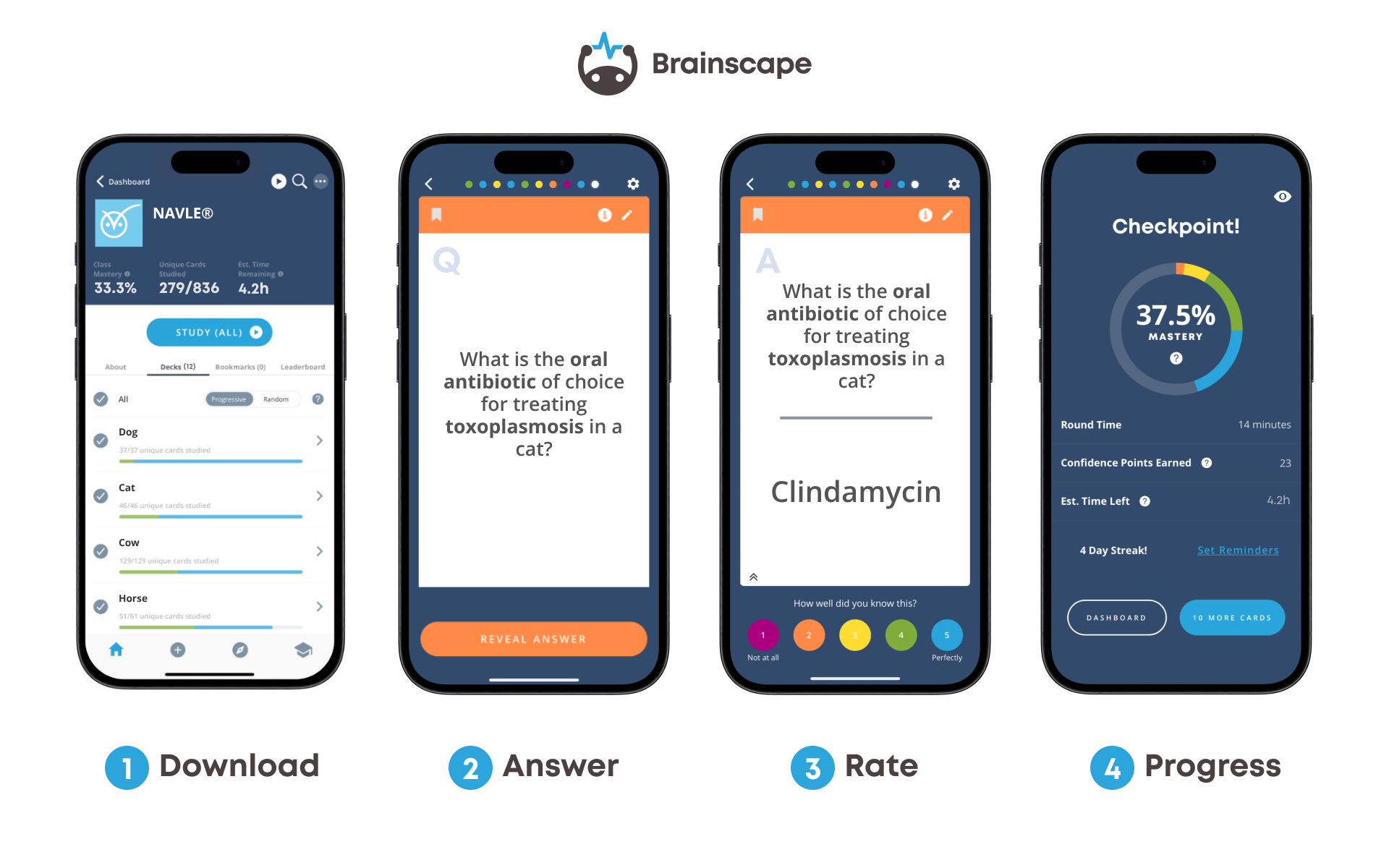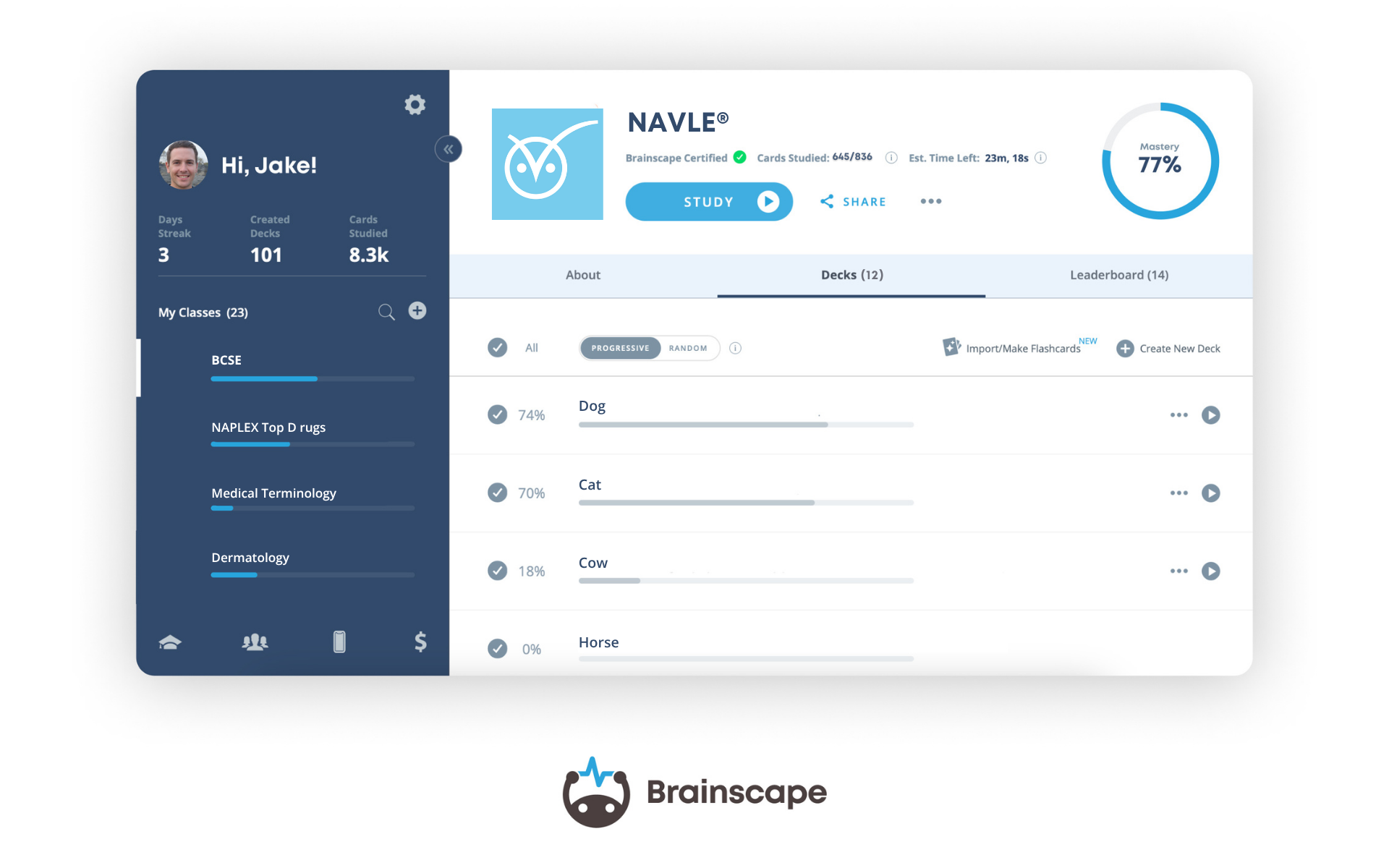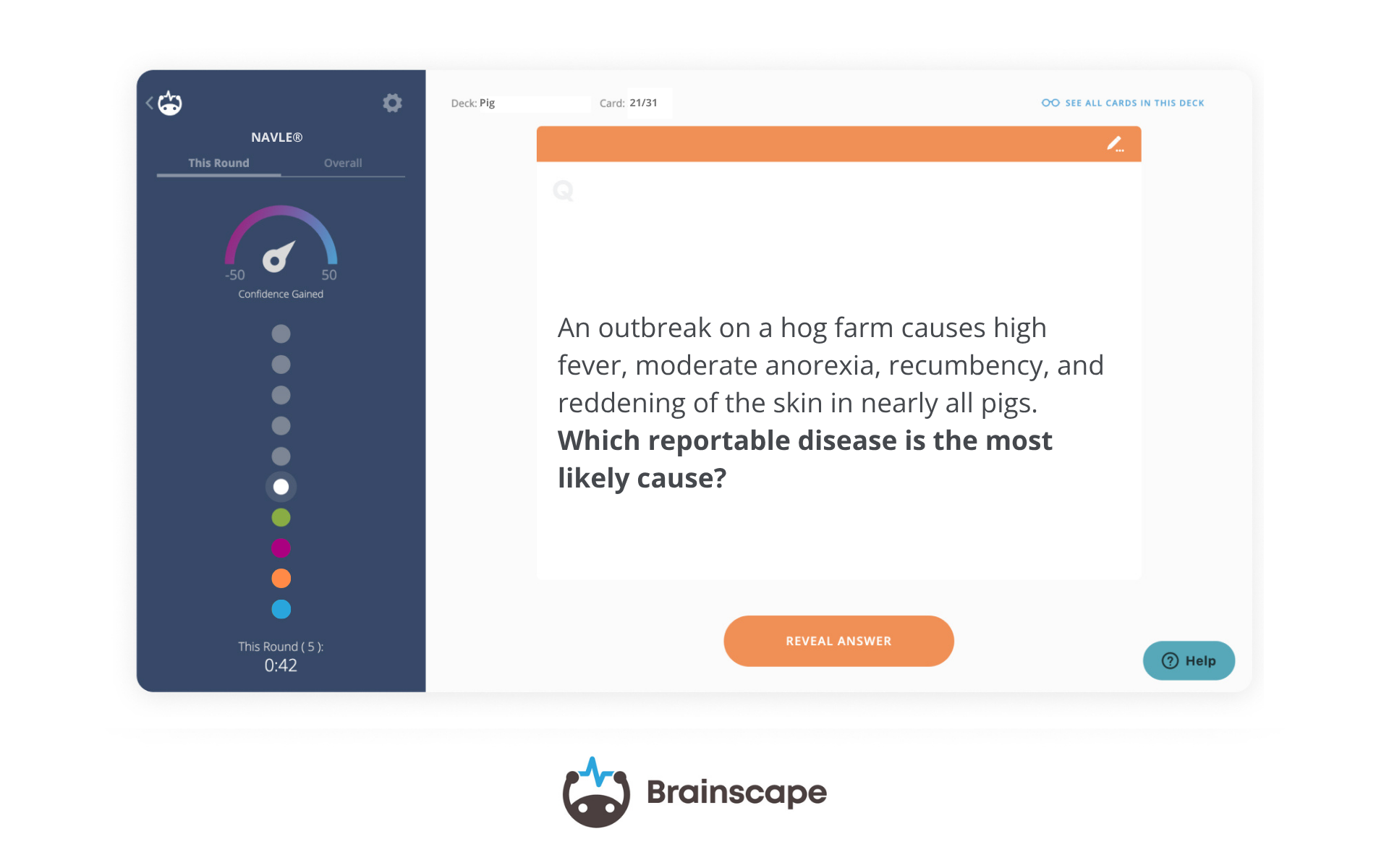If you’re preparing for the North American Vet Licensing Exam (NAVLE®), you already know the challenge: too much material, too little time, and a brain that doesn’t always cooperate.
The key is to study with strategy and purpose.
Veterinary medicine demands deep knowledge of anatomy, pharmacology, microbiology, diagnostics, and the unique details of every species. You simply can’t force all that into your memory in a few rushed weeks.
What you can do, however, is organize your time efficiently, focus on the most important topics, and use study tools (like web and mobile NAVLE flashcards) that help your brain remember information for the long haul.
In this NAVLE study guide, we’re going to empower you to build that kind of custom system: one that ensures that you are ready come exam day!
First, if you want to win the battle, you’ll need a sound strategy…
1. Build A Study Schedule That Works Backward From Your Exam Date
Before you open a single book, you need a strategy. A study schedule gives you the big-picture view of what to study, when to study it, and how to stay balanced. Without it, you’ll either burn out early or hit exam week realizing you never reviewed food-animal pharmacology.
Step 1: Find Your Total Study Window
Start by deciding how much time you have. Here’s what most candidates find realistic:
- Full-time study (5–6 days per week): 8–10 weeks
- Part-time study during rotations or work: 12–16 weeks
- Light review spread over time: up to 6 months
If you’ve already been reviewing NAVLE-style material during your rotations, you may not need as much time. Whatever you do, be realistic about your starting point and adjust accordingly. Also make sure you build in extra time in case something takes longer to master or you have a couple of sick days.
Step 2: Break The Exam Into Study Blocks
List the main content areas: small-animal internal medicine, large-animal medicine, equine, pharmacology, public health, and ethics. Then assign each topic a number of study days based on its exam weight and your comfort level.
Here’s an example of what that could look like:
- Small animal: Moderate confidence. 3 weeks of study
- Equine: Weak confidence. 2 weeks of study
- Food animal: Weak confidence. 2 weeks of study
- Pharmacology: Strong confidence. 1 week of study
- Misc./ethics/public health: Moderate confidence. 1 week of study
Step 3: Layer In Review And Question Practice
Each week should include a balance of:
- Learning days for reading, flashcards, and concept review
- Question practice days for timed blocks and mock exams
- Review days to revisit weaker areas and reinforce key points
Step 4: Use Study Tools That Keep You Organized
Study apps like Brainscape offer free study planner templates you can print or use digitally with no T&Cs. These help you allocate subjects, monitor progress, and schedule regular review sessions.
Remember, your goal isn’t to create a strict calendar; instead, you need to build a system that keeps you focused and consistent, so you always know what to study next.
2. Do High-Yield Topic Triage (Or: Don’t Treat Every Topic Equally)
Veterinary medicine covers a huge amount of material, and trying to study everything the same way is unrealistic. Effective NAVLE prep means directing your effort toward the areas that matter most. Think of it like managing a busy clinic: you can’t see every patient at once, so you focus first on the most critical cases.
Step 1: Focus On High-Yield Species And Systems
NAVLE questions concentrate on small-animal and food-animal medicine, with a fair share on equine topics and fewer on exotics or wildlife. That doesn’t mean you should ignore those subjects entirely, but your time should reflect their importance on the exam.
Start by emphasizing these key areas:
- Canine and feline internal medicine (endocrine, renal, gastrointestinal, cardiovascular, dermatologic)
- Equine lameness, colic, and reproduction
- Bovine and small-ruminant infectious diseases
- Pharmacology and therapeutics (antibiotics, anesthetics, parasiticides)
- Public health and zoonoses
- Diagnostics and lab-test interpretation
Step 2: Apply The “Power Of Weakness” Rule
Rate each topic from 1 to 5 based on your confidence level. Any topic that scores a 1 or 2 (your weaker areas) should be reviewed early in your plan. This gives you more chances to revisit the material. Practicing awareness around your own thinking is called metacognition and it’s a simple, yet effective technique to deepen your learning.

Digital flashcard tools like Brainscape and Anki are built on the principle of metacognition. They ask you to rate each flashcard based on how well you know it, then automatically schedule your next review at the optimal time. By focusing more on what you struggle with and less on what you’ve already mastered, you’ll learn far more efficiently.
Step 3: Balance Frequency And Difficulty
Some topics appear often and are challenging. Others are less common or easier to master. Organize your study time accordingly, for example:
- Canine endocrine disorders: High frequency, high difficulty > review weekly
- Equine colic: High frequency, medium difficulty > practice case questions
- Rabbit GI stasis: Low frequency, medium difficulty > review once near the end
Step 4: Track Patterns In Question Banks
As you work through question banks and flashcards, keep a running list of topics that appear repeatedly. If you notice “bovine respiratory disease complex” coming up in several sources, that’s a signal to study it in depth.
High-yield triage helps you recognize what the exam emphasizes most, rather than what your textbooks happen to spend the most pages on.
3. Make Practice Questions Part Of Your Daily Routine
You wouldn’t learn surgery by reading about it once. You’d learn by doing it. The same applies to NAVLE prep. The goal is not only to remember information but to recognize and apply it under exam conditions.
Why Practice Questions Work
- They turn passive studying into active recall, which strengthens memory and understanding.
- They help you recognize how exam questions are structured and what patterns to expect.
- They train your timing, focus, and decision-making under pressure.
How To Add Practice Questions To Your Study Plan
- Start early. In your first few weeks, include 10–20 practice questions a day alongside new material.
- Do timed sessions weekly. Once a week, complete a full test block of 60 questions in 60 minutes to build stamina and pacing.
- Review mistakes carefully. For every incorrect answer, write a short note to summarize the key point. Example: “Bovine mastitis: Staph aureus causes chronic infections; cull affected cows.”
- Track weak topics. Add them to your flashcards for targeted review.
If you’re looking for NAVLE-style exam questions, Brainscape’s NAVLE flashcards come with a free practice exam, emailed to you automatically when you sign up. Respected test prep providers like Zuku Review also offer expansive banks of free practice questions.
Example Weekly Schedule
- Mon–Thu: Study new content and complete 20 practice questions each day
- Fri: Timed 60-question test block
- Sat: Review weak topics and redo missed questions
- Sun: Rest or light review
Treat practice questions as a learning tool. They help you identify what still needs work and give you the test-taking skills and confidence to tackle the real exam.
4. Use Digital Flashcards To Lock In The Facts That Matter
The NAVLE covers an enormous amount of detail: drug classes, pathogens, anatomy, epidemiology, and the quirks of every species you can name. The only reliable way to master that content is through consistent, focused repetition.
Apps such as Mochi or Brainscape are ideal for this kind of learning, especially when used strategically.
Why Flashcards Work for NAVLE Prep

Flashcards work because they engage your brain in active recall. Instead of simply rereading notes or recognizing familiar information, you are forced to pull the answer from memory. That mental effort strengthens the neural pathways connected to that fact, making it far easier to remember later.
They also help you organize information in meaningful ways. You can group flashcards by topic, system, species, or whatever makes sense for how you study. This structure allows you to focus on one area at a time and build connections between related concepts.
Digital flashcards add another layer of science-backed efficiency through spaced repetition. This technique spaces out your reviews over time, showing you difficult cards more frequently and easier ones less often. Each time you successfully recall a card, the system increases the interval before you see it again. This method keeps facts fresh without wasting time on material you already know.
Finally, because flashcards are mobile-friendly, they fit seamlessly into your daily routine. You can study on the bus, between rotations, or before bed. With a mobile-friendly study app, you can study anywhere, anytime.
How To Use Flashcards Effectively
- Start early. Begin using a trusted flashcard set as soon as you plan your study schedule. Starting early allows more review cycles and better retention.
- Keep cards simple. Each card should focus on one idea. Example: “Causative agent of Potomac horse fever?” → Neorickettsia risticii.
- Tag by system or species. This makes it simple to isolate, for example, all bovine infectious diseases at once.
- Review daily. Twenty to thirty minutes a day is enough to keep your review cycle going strong.
- Rate your confidence. Tools such as Brainscape and Memrise let you rate each flashcard from 1 to 5, so the system shows weaker cards more often. This process, called metacognition, helps you focus on the areas that need more work.
- Keep everything synced. Use both web and mobile devices so you can study whenever you have a spare moment.
Why Flashcards Outperform Passive Review

Re-reading notes or highlighting slides often creates the illusion of learning. You just look at information passively, rather than testing your brain. Flashcards turn studying into a continuous process of deliberately retrieving information from your memory, which doubles your retention speed compared to passive study methods.
Passive study methods like multiple-choice quizzes or re-reading notes help you develop your recognition skills, but the NAVLE tests recall, not recognition. Flashcards strengthen recall, and that skill makes all the difference on exam day.
5. Simulate Real Exam Conditions
Studying efficiently also means preparing your mind and body for the experience of test day. The NAVLE is long and demanding, with seven hours, six question blocks, and 360 questions in total. To perform well, you need knowledge as well as stamina.
Run “Mock NAVLE Days”
At least twice during your preparation, take a full-length practice exam under conditions that feel like the real thing. Use question banks or official practice tests and follow these steps:
- Complete six 60-minute blocks
- Take one scheduled 15-minute break
- Keep your phone off and avoid interruptions
After you finish, reflect on how it went. Notice when your focus started to drop and which sections felt hardest. Then adjust your pacing, hydration, and nutrition plan for the actual exam.
Train Your Brain For Endurance
Build your stamina in stages. In your first week, complete one question block at a time. By week four, practice two blocks back-to-back. In your final month, aim to finish all six blocks with steady focus from start to finish.
Efficiency here means being ready for the full mental and physical challenge, not just the questions themselves.
6. Monitor Your Progress Like a Scientist
Efficient studying is data-driven. Keep track of metrics such as:
- Your percentage correct on practice tests
- The topics you miss most often
- Confidence ratings from your flashcards
- Total hours studied each week
Once you see patterns, use them to guide your study schedule. If your large-animal medicine scores are low, dedicate extra time there. If you’re already strong in diagnostics, reduce that focus and shift your effort elsewhere.
Progress-tracking tools from apps such as Brainscape and Quizlet (or even a simple spreadsheet) can help you visualize your improvement. Watching your progress grow keeps you motivated, and that motivation helps you stay consistent all the way to exam day.

Master The NAVLE With A Smart Study Strategy
Studying for the NAVLE efficiently means designing a system that balances structure, repetition, and reflection:
- Map your study window with a realistic schedule.
- Sort topics by yield and difficulty.
- Answer practice questions daily to sharpen reasoning and timing.
- Use digital flashcards to drill the brute-force facts quickly.
- Simulate test conditions to build stamina.
- Monitor progress and adjust focus areas dynamically.
When you study with structure and consistency, you spend less time spinning your wheels and more time mastering what really counts. The goal is not to memorize every page of veterinary medicine, but to develop a strong mental framework that helps you master the underlying concepts so you can confidently interpret and solve any exam question.
Brains learn through repetition and feedback, and that’s exactly why digital flashcards use spaced repetition to help you focus on weak areas, improve memory, and study efficiently. With a solid review course, practice questions, and digital flashcards, you’ll have everything you need to crush the NAVLE!
References
- Cepeda, N. J., et al. (2006). Distributed practice in verbal recall tasks: A review and quantitative synthesis.Psychological Bulletin, 132(3), 354–380.
- Dunlosky, J., Rawson, K. A., Marsh, E. J., Nathan, M. J., & Willingham, D. T. (2013). Improving students’ learning with effective learning techniques. Psychological Science in the Public Interest, 14(1), 4–58.
- ICVA (2024). North American Veterinary Licensing Examination (NAVLE) Candidate Bulletin.https://www.icva.net/navle/
- Zuku Review (2024). NAVLE® Study Strategy Guides. https://zukureview.com/
- Dr. Serena Vet Blog (2023). How to Study for the NAVLE. https://www.drserenapetvet.com/post/navle-how-to-study
